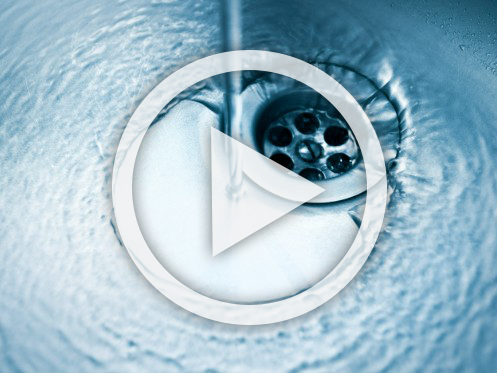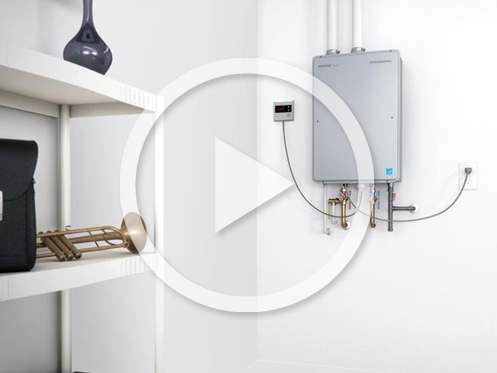Updated January 17, 2024

In February of 2020, Des Moines experienced record-breaking low temperatures that were well below freezing. This type of freezing weather is notorious for freezing pipes, which can burst and cause severe water damage.
To prevent your pipes from bursting and better prepare them for the upcoming winter season, we’ll go over six ways to winterize your pipes in Iowa:
- Open-Up Kitchen and Bathroom Sink Cabinet Doors.
- Let Your Indoor Faucets Drip a Little Bit.
- Drain the Water from Swimming Pools and Underground Irrigation Systems.
- Disconnect Outside Hoses and Insulate Outdoor Faucets with Covers.
- Insulate Exposed Pipes.
- Consider Adding Insulation to Areas That Get Extra Cold.
- Let’s explore each of these tips in more detail.
Need an experienced plumber to take a look at your pipes and provide recommendations? Contact Golden Rule for 5-star plumbing services. We’ve served the Des Moines area for more than 20 years, and we have the most qualified plumbers in the state.
Contact Us Today for Plumbing Service!
Open-Up Kitchen and Bathroom Sink Cabinet Doors.
Plumbing engineers typically construct homes with pipes underneath the kitchen and bathroom sinks. Cabinets house these pipe systems. During extreme weather conditions, it’s best to keep those cabinet doors open. That way, the warm air inside your home can keep them from freezing and bursting during the winter.
Let Your Indoor Faucets Drip a Little Bit.
The water inside your pipes can turn to ice if it sits at below-freezing temperatures for too long. If your faucet is off and the pipes aren’t running, they can burst.
Why do they burst?
Here’s how: If ice develops in a section of a pipe, it will push water towards the closed faucet, trapping it between the tap and the ice. The resulting pressure could cause the pipe to burst.
Letting your indoor faucet drip can relieve the pressure in the pipes and keep the water moving so it doesn’t freeze.
Although letting your indoor faucets drip might seem wasteful, you don’t need to let your faucets drip all day long. Plumbers usually recommend only doing this on frigid nights when the temperature in the Des Moines area dips well below-freezing temperatures for several hours at a time.
Drain the Water from Swimming Pools and Underground Irrigation Systems.
Swimming pool and sprinkler supply lines are two of the most significant frozen pipe risks, so it’s better to drain these lines entirely before the weather gets too cold. Follow the manufacturer’s instructions when doing this and try to avoid using antifreeze. The chemicals in antifreeze are incredibly harmful to people, pets, and the environment.
If you’d rather someone drain these lines for you before the winter freeze hits, a professional plumber can help.
Disconnect Outside Hoses and Insulate Outdoor Faucets with Covers.
If you leave your hose connected during winter, there could be water left inside it that may freeze, expand, and damage your hose valve. The best way to prevent this is to drain your hose and insulate your outdoor faucets.
Here’s a step-by-step explanation of how to drain and insulate:
- Close the inside valve that supplies water to your outside faucets. Look for the valve in your home, on the inside of the wall where the outdoor faucet is.
- Drain the inside valve. Have an empty bucket ready, and unscrew the small drain plug on the side of the valve to allow the water to drain out. TIP: Don’t forget to put the drain plug back on once you complete step four.
- Disconnect your garden hose. Go outside to your spigot and disconnect your hose. Ensure that you drain all of the water out before storing the hose for the winter.
- Drain the outside valve. Turn your spigot to the left (counterclockwise) to drain the remaining water from the outdoor valve. Then, turn it completely to the right (clockwise) to shut it off.
After you’ve completed these steps, you should place insulated faucet covers over your outdoor spigots. These covers are mitts you can put over your outdoor faucets for the winter. They help prevent your fixtures from freezing, expanding, and rupturing due to the cold. Manufacturers usually make them with styrofoam, rigid plastic, or nylon for efficient insulation. You can also contact a professional plumber to cover your outdoor spigots for you.
Insulate Exposed Pipes.
Certain pipes are more susceptible to freezing than others, such as those near the outer walls of your home, in crawl spaces, or in the attic. You can insulate them using a few different methods:
Heat tape:
To provide an extra layer of protection, wrap all exposed pipes with heat tape. Heat tape is essentially electrical wires covered with ribbon-like strips of plastic. You install it by wrapping the tape around your pipes and plugging it into an outlet. The tape will warm up and heat your pipes, preventing the water inside of them from freezing.
Just be careful while wrapping because heat tape can be a fire hazard. If you don’t follow the installation instructions carefully or purchase tape not approved by Underwriters Laboratories (UL), a safety certification body, it could start a fire in your home.
To avoid any safety issues, only buy heat tape approved by UL. Make sure that you can use the heat tape on water pipes, and you can plug it into a GFCI outlet as an extra safety precaution. Avoid putting insulation on top of the heat tape or wrapping it around the insulation. You can also consider hiring a professional to install the tape for you.
Pipe wrap tape:
Pipe wrap tape looks just like a roll of duct tape. To install it, wrap the pipe wrap tape around any exposed pipes, and it will provide a thick layer of insulation to keep them from getting too cold. It’s best for pipes with metal surfaces.
Pipe lagging:
Pipe lagging is also known as pipe insulation and consists of foam tubes that look like pool noodles that protect pipes from freezing in the winter. They come in various diameters, so you can choose based on how much insulating power you think you’ll need. Manufacturers make pipe lagging with foam or rubber-based insulation, and it’s easy to install on your own.
If you’ve had issues with exposed pipes freezing in the past, you may also want to consider relocating them. Doing so will require the assistance of an experienced plumber.
Consider Adding Insulation to Areas That Get Extra Cold.
Some interior areas in your home may get much colder than the main living spaces. Examples include basements, crawl spaces, attics, and garages. Exterior areas that contain outdoor water lines also could benefit from additional insulation. By adding insulation to these types of spaces, you will significantly reduce the chance of frozen pipes. Plus, insulation can help reduce outdoor noise, keep your home comfortable, and cut energy bills.
Before adding insulation to your home by yourself, we highly encourage you to consider the risks first. If you try to add insulation with little or no prior experience, you could end up installing it incorrectly, damaging your home, or choosing the wrong kind of insulation. Additionally, installing insulation can be a health hazard if you don’t have the right equipment to complete the job. It’s best to hire a contractor who is familiar with insulation and Iowa’s homebuilding best practices.
Need a Trustworthy Plumber in the Des Moines Area to Help You Winterize Your Pipes? Contact Golden Rule.
Golden Rule can help you prevent unnecessary damage to your pipes and home this winter. Our team offers the most robust customer protections, and we strive to honor the Golden Rule in everything we do. Give us a call to find out why we have more than 6,500 5-star trusted reviews.

Why Does Your Water Heater Take Forever to Warm Up? Let’s Fix It! Hey there, fellow homeowner! Have you ever noticed that when you turn on... Read More

Why Test Your Home’s Water? A Golden Rule Perspective Hey there, fellow homeowner! Have you ever wondered about the quality of the water flowing through your pipes?... Read More

Hey there, homeowner! Have you ever been in the middle of a soothing hot shower, only to have the water turn icy cold? It’s a bummer. Well,... Read More
